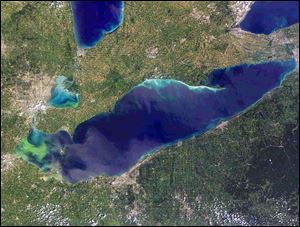
Lake Erie algae bloom expected to be smaller by summer's end
Researchers seeking long-term answers
7/6/2012
This satellite photo shows Lake Erie in 2011. The green coloration at left is an algae bloom that grew over a section of the lake.
GIBRALTAR ISLAND, Ohio -- Last summer, harmful algae covered a Long Island-sized area of water in Lake Erie, ramping up the cost of water treatment, sickening pets, and driving tourists away from beaches.
But state and federal officials Thursday predicted good news: This year, the algae bloom will likely be only about one-tenth the size of the bloom that spread across Lake Erie's western basin in 2011.
"The key question was: what will happen next?" said Jeff Reutter, director of Ohio State University's Sea Grant program, at a news conference held Thursday at the Ohio State University Stone Laboratory on Gibraltar Island.
The National Oceanic and Atmospheric Administration has issued weekly forecasts for harmful algae blooms for several years, but this year, a team of researchers from the organization, along with experts from Heidelberg University and Ohio Sea Grant, collaborated to develop models that can cast a seasonal prediction. They used 10 years of data on nutrients entering Lake Erie as well as information collected from a European Space Agency satellite.
Their prediction of a mild algae bloom for this year reverses a disturbing trend that developed and worsened over the last four years.
"The 2011 bloom was certainly the worst in decades and possibly the worst ever that has appeared in the lake," said Richard Strumpf, a NOAA oceanographer.
Mr. Reutter added: "This is great news for this year, but we haven't solved this problem yet."
The break from severe algae blooms has nothing to do with a solution for their underlying causes, he said.
This year has been especially dry, but usually abundant rainwater washes nutrients into the lake that cause toxin-producing algae to thrive. Runoff from farmland and effluent from wastewater treatment plants and leaking septic systems increases the phosphorus available to algae. Scarcity of phosphorus should limit the algae population, and without this restraint, algae take over the lake, covering the water in a green film that sticks to skin like wet paint, officials said.
"Last year, we saw the largest amount of phosphorus -- and water for that matter -- going down the rivers and into the lake that we've seen in 35 years of following the Maumee River," Mr. Reutter said.
This spring, much less water entered the lake, and the phosphorus load was 3 percent of the amount last year: "The fuel to fire the bloom, the phosphorus, is greatly reduced," he said.
The good news, however, is only temporary, he stressed.
"This is buying us a year of time. If we could reduce phosphorus loading significantly, this problem would basically go away," he said.
While Mr. Reutter remains confident that algae blooms could be banished from Lake Erie with the right amount of commitment, he and several scientists from NOAA Thursday stressed the importance of continually monitoring the lake, even when no green scum mars its surface.
Algae blooms plagued Lake Erie in the 1960s and '70s, but after companies removed phosphates from detergent and sewage plants aggressively improved waste treatment, the problem largely vanished. Then in 1995, an algae bloom reappeared in Lake Erie.
"When we solved the problem in the mid-1980s, and the lake became the walleye capital of the world, it became very hard to keep that much money monitoring a problem that no longer existed," said Mr. Reutter. "We solved the problem once, and it's back now."
Contact Sophie Broach at: sbroach@theblade.com or 419-724-6210.